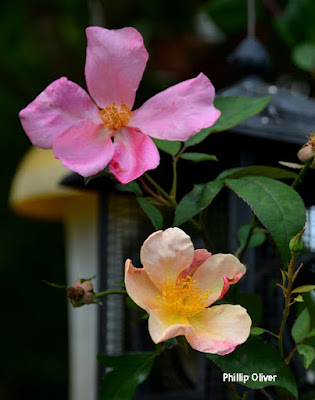I first fell in love with
Mutabalis about twenty years ago and every time it blooms, I am head over heels in awe all over again. It is an unusual rose and has many unique charms. A china rose, introduced before 1894, its origins are obscure. Swiss botanist Henri Correvon is credited with introducing it to the market in 1934. He had been gifted the rose forty years earlier by Prince Gilberto Borromeo who grew it on Isola Bella, his estate on Lake Maggiore. Correvon called it '
Mutabalis' for it color-changing nature. It is also known as '
Tipo Ideale'. For many gardeners, it is simply "The Butterfly Rose" because when in full bloom, it resembles a flock of them.
The color changing nature of Mutabalis is one of its unique features. Most roses fade as they age but not this one. Copper colored buds open to a deep yellow and often the two colors meld to a striking blend. On the second day, the color changes to pink and finally a deep crimson.
Of course the flowers are beautiful but I find the foliage just as satisfying. It is a twiggy rose and the stems and thorns are dark red. China roses have a particular elegance about them and Mutabalis is no exception. I find it to have an Asian feel and it would be a nice rose for a Japanese garden. Although most china roses are compact in nature, Mutablis is robust. It easily reaches 5-6 feet in height and width and probably more if allowed to go unchecked. I cut it back several times during the year and it responds quickly by sending out vigorous new shoots.
My first attempts to grow it in the Alabama garden were ill-fated. The first plant succumbed to what I thought was a not-so-harsh winter. However, this is a tender rose, and it is best to give it a sheltered location, ideally in a protected niche or against a sunny southern-facing wall to do its best.
The final positive note on this spectacular rose is that it is quite disease resistant. A little blackspot may show up from time to time but never of any significance. It has also not shown any signs of mildew and here in southern Washington, that has been a problem with other roses.
Text and photos by Phillip Oliver, Dirt Therapy







Beautiful! Do they have any scent?
ReplyDeleteKim, unfortunately no!
DeleteSaw it on the Portland Fling at the Kuzma garden, it was stunning. Here the drier climate seems to toast and shrivel the foliage as well as the flowers--it always looked thirsty. Perhaps within a few blocks of the Pacific here is ideal.
ReplyDeleteI, too, love my Mutabalis rose, but be forewarned—ours is approximately 15' tall and as wide. It has swallowed up half of my Vern's Brown Turkey fig tree.
ReplyDeleteWould you be appalled to hear that my husband, at my request, just took mine out? It's not that I don't think the flowers are beautiful - I do - but I inherited 3 struggling shrubs on a shady slope with our current house nearly 10 years ago. When our next door neighbor removed a hedge that lent a lot of that shade a few years ago, I'd hoped the shrubs might live up to expectations but they didn't. (Gophers may have had an impact too.) They were in the wrong place and really none of the roses here have done well so I finally faced the fact that I need to work with conditions in my current garden rather than against them.
ReplyDelete